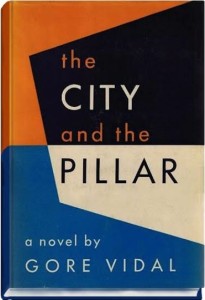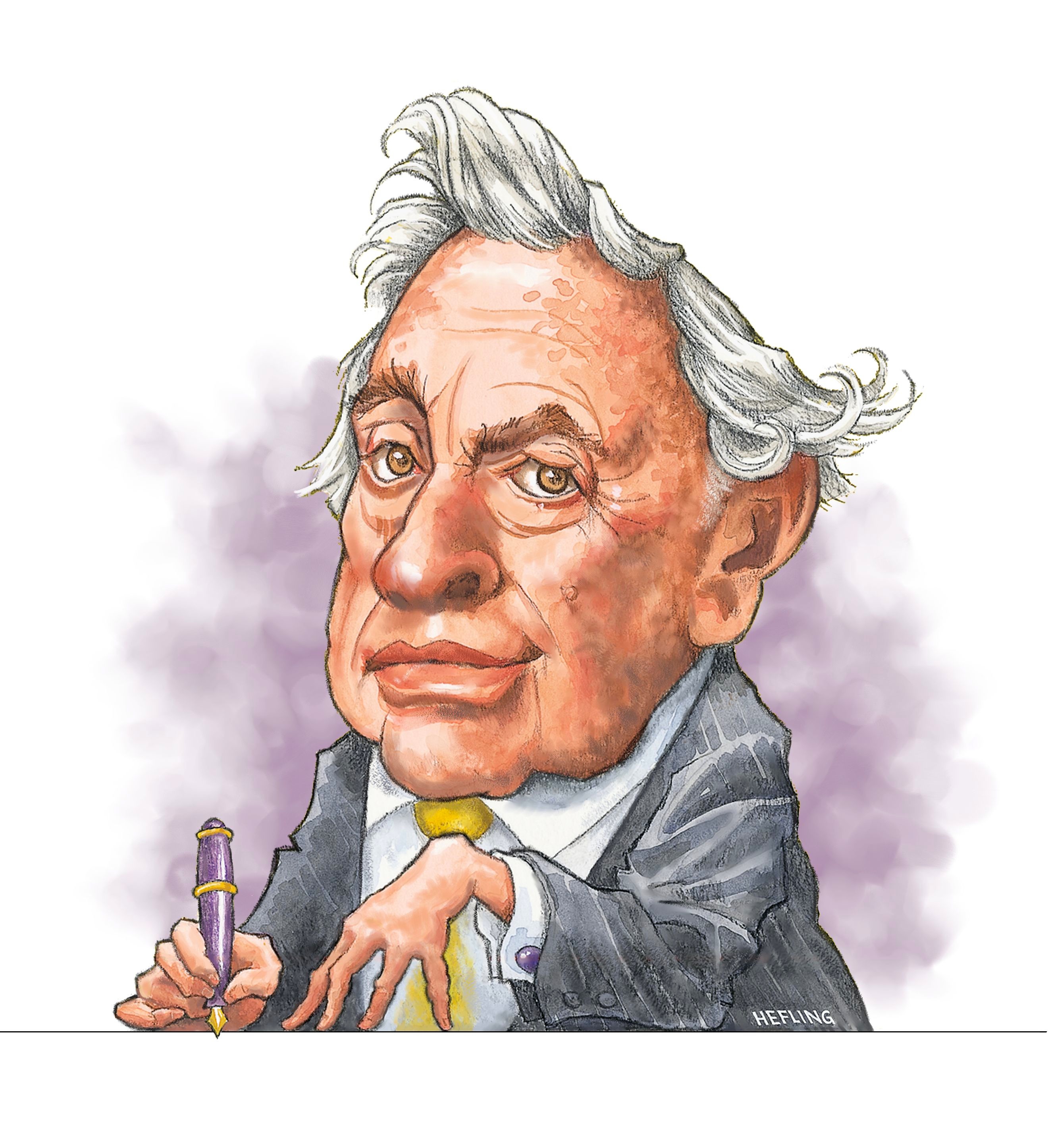GORE VIDAL died in 2012, at 86, and The New York Times obituary reluctantly conceded that his claim of having been blacklisted by the newspaper for writing The City and The Pillar “may have been right.” The publication of an explicitly gay novel was  unprecedented in 1948. The arc of Vidal’s life was circumscribed by the book. Until his mid-20th-century arrival, no public person in the English-speaking world had identified himself as a sexual nonconformist since Oscar Wilde. (Of course, Vidal persistently rejected the label “gay” as a matter of personal identity throughout his life.)
unprecedented in 1948. The arc of Vidal’s life was circumscribed by the book. Until his mid-20th-century arrival, no public person in the English-speaking world had identified himself as a sexual nonconformist since Oscar Wilde. (Of course, Vidal persistently rejected the label “gay” as a matter of personal identity throughout his life.)
Because our culture is both reductionist and sensationalistic, Vidal is contemplated posthumously as he was during his lifetime. First, he was defined by those with whom he had sex, which might include sailors in New York’s Times Square, a Sardinian hustler in Ravello, working-class men anywhere, underage boys in Bangkok (or so he was accused), or Hollywood movie stars. Evidently, his body type was male. Second, he was defined by those with whom he did not have sex, principally Howard Austen, his life-long companion.
Vidal said, “You don’t write The City and the Pillar unless you think there’s something eternal sitting there that needs to be said.” He wrote 25 novels, 26 nonfiction works, fourteen screenplays, and eight stage plays. But he never again wrote a gay-themed novel, arguably a genre he created. The cost may simply have been too great.
The following is excerpted from an essay that appeared in the March-April 2010 issue. — SFD
WHEN GORE VIDAL wrote his breakthrough novel The City and the Pillar in 1948 at the age of 22, it marked him as arguably the first openly gay American novelist. The City and the Pillar was controversial when it was published. It wasn’t reviewed by The New York Times, which refused to take any advertising for the novel, and the Times didn’t review any of Vidal’s work for nearly a decade. Vidal believes he was blacklisted for purely homophobic reasons. Summing up reaction to the novel, Vidal remarked: “It was believed in right-wing circles that I invented same sexuality in 1948 with The City and the Pillar , that nothing like that had ever happened in the United States until my book. I feel like Prometheus having brought fire from heaven.” When Vidal announced his candidacy for U.S. Congress in 1960 to represent the Southern Tier region of New York, he received an anonymous call warning him that if he continued to run, a million copies of The City and the Pillar would be distributed from Fishkill to Hudson. “Make it two million and I’ll draw out.”
Vidal has stated that “The City and the Pillar has nothing of me in it” and, on another occasion, that “I’m the least personal of writers.” But one can’t help but notice that the protagonist, Jim, is a young man from Virginia who joins the Navy and goes to war, where he meets Bob, his sexual and spiritual “twin,” falls in love, and broods a great deal about the affair. Thematically, it’s essentially an early coming-out novel. Jim progresses through predictable, same-sex developmental stages, from acknowledging confused sexual feelings through sexual and social experimentation to exploration and involvement in sexual relationships. The novel is dedicated to JT, acknowledged by Vidal in Palimpsest to be Jimmie Trimble, who died at nineteen on Iwo Jima. A photo of Trimble appears twice in Snapshots. There’s a clear parallel between the Vidal–Trimble and the Jim–Bob pairings in real life and in the novel. In Palimpsest, Vidal declared Trimble “the unfinished business of my life.”
Vidal looks with disdain upon queer studies, rebukes same-sex identity politics—“There is no such thing as a homosexual or a heterosexual person. There are only homo- or heterosexual acts”—and disdains notions of a “gay sensibility.” Notwithstanding his reluctance to be labeled as gay, any reasoned account will place Vidal in the foreground of gay intellectual history. Decades before the founding of the modern GLBT movement, he admonished: “You have got to keep going as far out as you can, as far as your 
FEW INTELLECTUALS in our society have lived in the klieg-lit glare of public notice the way Gore Vidal has. The son of an aviation pilot who dated Amelia Earhart and the grandson of an Oklahoma founder and its first senator, Vidal shares a stepfather with Jacqueline Kennedy, is cousins with former President Jimmy Carter and Vice President Al Gore, and was friends with Tennessee Williams, Joanne Woodward and Paul Newman, and Christopher Isherwood, among many others. A 2009 “visual memoir” titled Gore Vidal: Snapshots in History’s Glare contained images of Vidal with friends and acquaintances such as Marlon Brando, William Burroughs, Truman Capote, Christopher Fry, Allen Ginsberg, Mick Jagger, and Andy Warhol, to name but a few.
Vidal has famously engaged in personality-driven debates for decades throughout his career, boasting that “I never miss a chance to have sex or appear on television.” He and William F. Buckley were infamous opponents. During the 1968 Republican Presidential Convention in Chicago, they appeared together on ABC-TV. Vidal opposed the Vietnam War and Buckley supported bombing North Vietnam into oblivion. The dialogue became ferociously contentious. Vidal: “Shut up a minute. As far as I’m concerned, the only crypto-Nazi I can think of is yourself.” Buckley: “Now listen you queer. I’ll sock you in the god-damn face and you’ll stay plastered.”
In a 1971 New York Review of Books essay, Vidal went after a trio of men he dubbed “M3” for Henry Miller, Norman Mailer, and Charles Manson, suggesting that each “has been conditioned to think of women as, at best, breeders of sons; at worst, objects to be poked, humiliated, killed.” He and Mailer appeared together on The Dick Cavett Show and had the following exchange. Mailer: “You’re a liar and a hypocrite. … Are you ready to apologize?” Vidal: “I would apologize if it hurts your feelings. Of course I would.” Mailer: “No, it hurts my sense of intellectual pollution.” Vidal: “As an expert you should know about that.”
His feuds have been interminable, legendary, and sometimes litigious. He admitted that “litigation takes the place of sex at middle age.” His conflict with Truman Capote, whom he once thought of as a “bright wit [with]sweet charm,” turned into open warfare. He instituted a million-dollar lawsuit because of a 1975 Playgirl interview in which Capote charged that Vidal was physically ejected from a White House party given by John F. Kennedy because of drunken and obnoxious behavior. Currently Vidal is engaged in an acrimonious battle with Edmund White. He once wrote, “I like Edmund White, particularly Nocturnes for the King of Naples—a lovely book.” But, now he thinks White is “a filthy, low writer.” And White called Vidal an “awful, nasty man.” The dispute arose because of White’s play Terre Haute, which was inspired by correspondence between Vidal and Timothy McVeigh, who was executed in 1995 for the bombing of the Alfred P. Murrah Federal Building in Oklahoma City. “That play implies I am madly in love with McVeigh. … I’m more interested in the Constitution and McVeigh than the loving tryst he saw. It was vulgar fag-ism.” The films Capote (2005) and Infamous (2006) allude to a psychosexual attraction held by Capote for Perry Smith, one of the murderers in the nonfiction novel In Cold Blood (1965). The suggestion that there was a similar dynamic at work with Vidal and McVeigh set off something akin to catalytic rage in Vidal.
Vidal is not squeamish about challenging presidents, or would-be presidents. Of the Kennedys he said, “I never believed in Jack’s charisma. … He was one of our worst presidents,” while Bobby was “a phony, a little Torquemada,” and Joseph, the family patriarch, “a crook—should have been in jail.” He quipped that Ronald Reagan was “a triumph of the embalmer’s art.” On the George W. Bush administration: “The Bush people have virtually got rid of Magna Carta and habeas corpus. In a normal republic I would probably have raised an army and overthrown them. It will take a hundred years to put it all back.” Of John McCain: “He’s a goddamned fool. … He should have been court-martialed.” Of Hillary Clinton: “I’d always rather liked her. She’s a perfectly able lawyer. … But this long campaign, this daily search for the grail, has driven her crazy.” He wrote that Barack Obama was doing “dreadfully” and explained: “I was hopeful. He was the most intelligent person we’ve had in that position for a long time. But he’s inexperienced. He has a total inability to understand military matters. … He’s absolutely bowled over by generals, who tell him lies and he believes them.”
Vidal is an indefatigable social critic, commenting on the state of our democracy: “The United States is a madhouse. The country should be put away and we’re being told to go away. Nothing makes any sense.” Commenting on some famous homophobes, he remarked: “I believe that as the highest-ranking member of the U.S. Senate, Mr. [Trent] Lott should be charged with incitement to violence and to murder, specifically in the case of Matthew Shepard, and that Mr. [Gary] Bauer and others who have indulged in the same reckless demonizing of millions of Americans be equally charged.” On feminism: “The hatred these girls have inspired is to me convincing proof that their central argument is valid.”
Dennis Altman argued in Gore Vidal’s America (2005) that the novel Myra Breckenridge (1968) was part of a “major cultural assault on the assumed norms of gender and sexuality.” Myra Breckinridge is a male-to-female transgendered mythic heroine—“I am Myra Breckinridge whom no man will ever possess”—who set out to “change the sexes, to re-create Man.” In 2006’s Point to Point Navigation, Vidal claimed that “it was not until I was halfway through the story that I realized she had been a male film critic who had changed his sex. Myron had become Myra. Why? I wrote on, laughing.” Margot Hentoff, in her review of the novel in The New York Review of Books, said that it conjured “the ultimate shared fantasy of the age—a future of androgynous independence.”
Myra seems more a literary device than an authentic character: she’s a verbatim mouthpiece for many of Vidal’s perspectives on gender and sexuality, such as his views on bisexuality. “I do share the normal human response to whatever is attractive physically in either sex. I say normal human response, realizing that our culture has resolutely resisted the idea of bisexuality. We insist that there is only one right way of having sex: man and woman joined together to make baby; all else is wrong.” Or his view of über-masculinity: “The young men compensate by playing at being men, wearing cowboy clothes, boots, black leather, attempting through clothes (what an age for the fetishist!) to impersonate the kind of man our society claims to admire but swiftly puts down should he attempt to be anything more than an illusionist, playing a part.”
Steven F. Dansky, a political activist, writer, and photographer for nearly a half-century, is a frequent contributor to this magazine.






